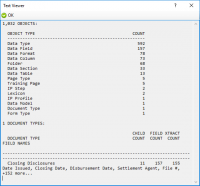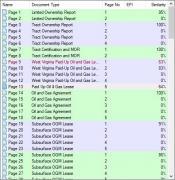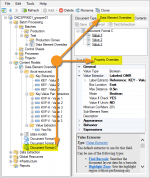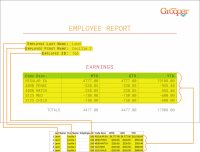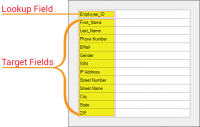Main Page: Difference between revisions
Dgreenwood (talk | contribs) No edit summary |
Dgreenwood (talk | contribs) No edit summary |
||
| (11 intermediate revisions by the same user not shown) | |||
| Line 12: | Line 12: | ||
|[[Install and Setup]] | |[[Install and Setup]] | ||
|-style="background-color:#fde6cb" valign="top" | |-style="background-color:#fde6cb" valign="top" | ||
|[ | |[https://grooper.bisok.com/Documentation/2.90/Main/HTML5/index.htm#t=Start_Page.htm 2.90 Reference Documentation] | ||
|} | |} | ||
| Line 21: | Line 21: | ||
|-style="background-color:#d8f3f1" valign="top" | |-style="background-color:#d8f3f1" valign="top" | ||
| | | | ||
<blockquote style="font-size:14pt"> | <blockquote style="font-size:14pt"> | ||
[[Data Context]] | |||
</blockquote> | </blockquote> | ||
Data without context is meaningless. Context is critical to understanding and modeling the relationships between pieces of information on a document. Without context, it’s impossible to distinguish one data element from another. Context helps us understand what data refers to or “means”. | |||
This allows us to build an extraction logic using '''[[Data Type]]''' and '''[[Field Class]]''' extractors in order to build and populate a '''[[Data Model]]'''. | |||
There are three fundamental data context relationships: | |||
* '''Syntactic''' - Context given by the syntax of data. | |||
* '''Semantic''' - Context given by the lexical content associated with the data. | |||
* '''Spatial''' - Context given by where the data exists on the page, in relationship with other data. | |||
Using the context these relationships provide allows us to understand how to target data with extractors. | |||
| | | | ||
The ''' | You can now manually manipulate the confidence of an extraction result. The '''''[[Confidence Multiplier and Output Confidence]]''''' properties of '''[[Data Type]]''' and '''[[Data Format]]''' extractors allow you to change the confidence score of extraction results. No longer are you forced to accept the score Grooper provides. These properties give you more control when it comes to what confidence a result ''should'' be. | ||
This allows you to prioritize certain results over others. You can create a kind of "fall back" or "safety net" result by using this property. You can even ''increase'' the confidence of an extractor's result, allowing you to give more weight to a fuzzy extractor's result over a non-fuzzy one, for example. | |||
For more information visit, the [[Confidence Multiplier and Output Confidence]] article. | |||
|} | |} | ||
| Line 116: | Line 119: | ||
* [http://grooper.bisok.com/Documentation/2.80/Main/HTML5/index.htm#t=Start_Page.htm 2.80 Reference Documentation] | * [http://grooper.bisok.com/Documentation/2.80/Main/HTML5/index.htm#t=Start_Page.htm 2.80 Reference Documentation] | ||
* [http://grooper.bisok.com/Documentation/2.80/SDK/HTML5/index.htm#t=Developer_Reference.htm 2.80 SDK Documentation] | * [http://grooper.bisok.com/Documentation/2.80/SDK/HTML5/index.htm#t=Developer_Reference.htm 2.80 SDK Documentation] | ||
* [https://grooper.bisok.com/Documentation/2.90/Main/HTML5/index.htm#t=Start_Page.htm 2.90 Reference Documentation] | |||
|style="width:25%"| | |style="width:25%"| | ||
* [https://blog.bisok.com/webinars Webinars and Video] | * [https://blog.bisok.com/webinars Webinars and Video] | ||
Revision as of 10:02, 23 September 2020
| Getting Started | |||
|
Grooper is a software application that helps organizations innovate workflows by integrating difficult data. Grooper empowers rapid innovation for organizations processing and integrating large quantities of difficult data. Created by a team of courageous developers frustrated by limitations in existing solutions, Grooper is an intelligent document and digital data integration platform. Grooper combines patented and sophisticated image processing, capture technology, machine learning, and natural language processing. Grooper – intelligent document processing; limitless, template-free data integration. |
Getting Started | ||
| Install and Setup | |||
| 2.90 Reference Documentation | |||
| Featured Articles | Did you know? |
|
Data without context is meaningless. Context is critical to understanding and modeling the relationships between pieces of information on a document. Without context, it’s impossible to distinguish one data element from another. Context helps us understand what data refers to or “means”. This allows us to build an extraction logic using Data Type and Field Class extractors in order to build and populate a Data Model. There are three fundamental data context relationships:
Using the context these relationships provide allows us to understand how to target data with extractors. |
You can now manually manipulate the confidence of an extraction result. The Confidence Multiplier and Output Confidence properties of Data Type and Data Format extractors allow you to change the confidence score of extraction results. No longer are you forced to accept the score Grooper provides. These properties give you more control when it comes to what confidence a result should be. This allows you to prioritize certain results over others. You can create a kind of "fall back" or "safety net" result by using this property. You can even increase the confidence of an extractor's result, allowing you to give more weight to a fuzzy extractor's result over a non-fuzzy one, for example. For more information visit, the Confidence Multiplier and Output Confidence article. |
| New in 2.9 | Featured Use Case | ||||||||||||||||||||||||||||||||||||
|

Discover how they:
| ||||||||||||||||||||||||||||||||||||
| Other Resources | |||
|
|||

